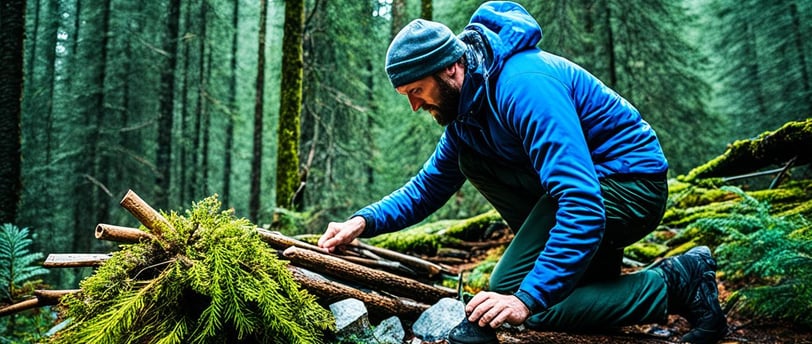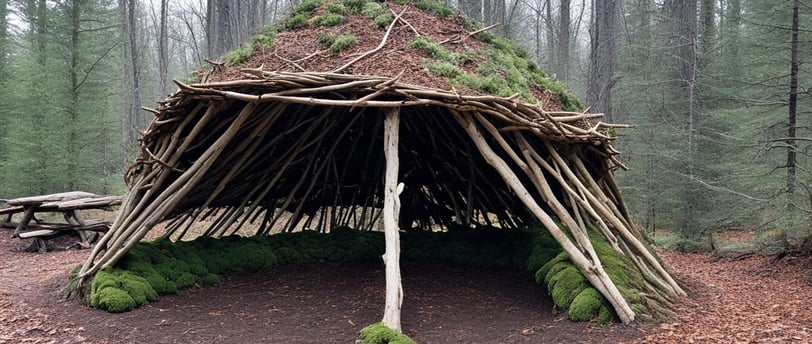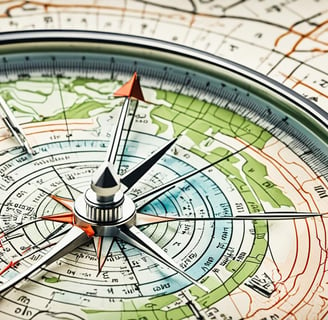Essential Survival Skills Everyone Should Master
Imagine being in a life-or-death situation with no help around. Would you know how to survive? If you love the outdoors or just want to be ready for anything, learning key survival skills is vital. These skills can save your life in an emergency. We'll cover 10 important skills everyone should know before a real crisis.
The Bug Out Bunker
8/14/202410 min read


Key Takeaways
Survival skills are crucial for outdoor lovers and anyone wanting to be ready for emergencies.
Learning how to build a fire, purify water, forage, give first aid, and navigate is key.
Having the right mindset is as important as knowing how to do these things.
With the right knowledge and practice, you can boost your chances of surviving a life-or-death situation.
Spending time learning survival skills now can greatly help if you're ever in a real emergency.
Mastering Fire Building Techniques
Fire is key for survival, offering warmth, light, and a way to cook food. Learning how to build a fire is vital for anyone who loves the outdoors or needs survival skills. We'll look at how to find and prepare tinder and build a fire pit that lasts.
Finding and Preparing Tinder
Starting a fire starts with the right tinder. Use dry grass, twigs, or dryer lint because they burn easily. For a dependable tinder, try making a feather stick or finding amadou fungus on trees. Quartz can also spark and help light your tinder.
Constructing a Sustainable Fire Pit
Creating a fire pit is key for a safe, controlled fire. Pick a spot away from trees, leaves, or anything that can catch fire. Clear a circle and dig a shallow hole. Use rocks to surround the pit, keeping the fire in check and easy to put out.
Getting good at fire building is a big part of improving your survival skills and bushcraft skills. With time and effort, you'll be able to start fires anywhere, keeping you safe and comfortable outside.
Sourcing and Purifying Water
Finding and making clean drinking water is key in the wild or during emergencies. There are a few good ways to purify water that can save your life.
Building a Solar Still
Without a steady water source, a solar still can be a lifesaver. This device uses the sun to pull moisture from the ground and turn it into clean water. Dig a hole, cover it with a tarp or plastic, and put a container in the middle to collect the water.
Improvised Water Filtration Methods
Using a t-shirt or clean fabric to filter out big particles is a simple way to purify water.
For a better filter, mix charcoal from your fire, sand, and small rocks in an upside-down PET bottle.
When dealing with water purification and wilderness water, it's always best to be careful. Boiling water is a reliable way to kill harmful bacteria and make your emergency water safe.
"Sourcing clean drinking water is perhaps the single most important skill needed in a survival situation."
Foraging for Edible Plants
In a survival situation, finding and eating wild plants is crucial. Many tasty and healthy wild plants are easy to find. But, it's hard to tell which ones are safe to eat because they look a lot like harmful ones.
There are a few plants that are easy to spot and safe to eat. They are full of important vitamins and minerals. These include:
Stinging nettle - High in protein, iron, and vitamins A and C
Dandelion - Loaded with antioxidants, vitamin K, and calcium
Lamb's quarters - Rich in vitamins A, C, and K, as well as minerals like iron and magnesium
Miner's lettuce - A tender, nutrient-dense green that's delicious in salads
Don't try to forage for mushrooms or fungi because many can be poisonous. Instead, learn to find and pick the safe plants in your area. With practice, you can become great at foraging. This skill can be very useful in a survival food situation.
"Knowing which plants are edible can be the difference between life and death in a survival scenario."
3 survival skills anyone should know
Learning to tie knots, make traps, and use primitive tools can greatly improve your survival chances in the wild. These skills are often not thought of as important but can be crucial in survival situations. They can mean the difference between living and dying.
Tying Essential Knots
Knot-tying is a key skill for outdoor activities. It helps you build shelters, keep things safe, and even make tools. Knowing how to tie different knots, like the bowline and clove hitch, is essential. With practice, tying knots can become easy.
Constructing Basic Traps and Snares
Traps and snares can make getting food easy with little work. There are many ways to set traps, from simple noose traps to complex deadfall traps. It's important to learn about the local wildlife and practice different trap types to be successful.
Learning how to fish using primitive methods can also be very helpful. You can make hooks from thorns or weave fish traps. These skills can help you find more food and stay well-fed during tough times.
"Mastering essential survival skills like knot-tying and trap construction can mean the difference between life and death in the wilderness."
Whether you're experienced or new to the outdoors, improving these basic survival skills is important. Spending time practicing these skills can make you more self-reliant and ready for survival challenges. By getting better at these techniques, you'll be a more skilled adventurer.
Crafting Primitive Weapons
In the wilderness, having the right survival tools is key. The slingshot is a simple yet effective weapon you can make from natural materials. You can find these in your own backyard.
Making a Slingshot from Natural Materials
Learning to make a slingshot is a great bushcraft skill. It can protect you and help you find food in tough situations. You'll need a few basic items to get started:
A sturdy, forked stick or branch
Rubber tubing or strips of natural latex
Leather, canvas, or fabric for the slingshot pouch
First, pick a forked stick or branch that feels good in your hand. Make sure it has strong prongs. Cut the ends to the right length, then attach the rubber tubing or latex strips. Use a strong knot or glue to secure them.
Next, make a pouch. Cut a small square from leather, canvas, or fabric. Attach it to the rubber bands in the middle.
"A slingshot is an underrated survival tool that can provide both protection and a means to gather food when you're in the wilderness."
Now, take your slingshot to a safe place and practice. Always wear eye protection. Work on getting better at aiming and shooting. This simple weapon can be a big help in defending yourself and for bushcraft.
Building Wilderness Shelters
Finding shelter is crucial when lost in the wilderness. A safe spot to escape the elements can be tough to find. Building a wilderness shelter or survival shelter from nature means doing less work to get basic protection.
Selecting an Ideal Shelter Location
Choosing the right shelter location is key for a stable and effective shelter. Think about how close it is to water, wind direction, and the land's shape. Look for caves or thickets that can be a strong base for your shelter.
Utilizing Natural Insulation Materials
Using natural insulation materials is important for a good wilderness shelter. Find lots of leaves, branches, and other natural stuff to make a thatched roof or insulate your shelter. These materials help keep you warm and safe from the weather.
"The wilderness is not a luxury but a necessity of the human spirit."
- Edward Abbey
By picking the right shelter location and using natural insulation materials, you can make a wilderness shelter that keeps you safe and comfy outside.
Basic Wilderness First Aid
When you go into the wild, things can turn unexpected. Accidents, injuries, or emergencies can happen, and help might be far away. That's why learning basic wilderness first aid is key for outdoor lovers.
Knowing how to do the CPR procedure is vital. If someone in your group stops breathing and is not awake, CPR could save their life. Also, stopping bleeding, treating burns, fixing broken limbs, and using plants to ease insect bites and cuts can be crucial in the wild.
"Being ready with a first aid kit is as important as knowing how to use it. It could save your life or someone you care about."
Spending time to learn wilderness first aid and survival medicine skills is smart. These skills are key for handling emergency medical situations outdoors. With the right knowledge and tools, you can manage medical emergencies and serious situations in the wild.
Get to know the CPR procedure
Learn to stop bleeding and treat burns
Know how to fix broken limbs
Find plants to ease insect bites and cuts
Put together a full first aid kit for your outdoor trips
Navigation and Orienteering
In the wilderness, learning to read a map and use a compass is key. Don't just count on your smartphone's apps, as batteries can run out and signals can be weak or gone in survival situations. Topographic maps show the landscape's features, helping you plan your path. Using a compass with a map lets you find your way without your phone.
Reading Topographic Maps
Topographic maps are great for navigation and orienteering. They show the terrain's height, features like rivers and mountains, and more. By learning the map's symbols and lines, you can see the land's layout and find safe paths or your goal.
Using a Compass Effectively
A compass is key for wilderness navigation. It helps match your map with the right direction. This makes moving through unknown areas easier. Always check your compass works right and watch out for things that might mess with its accuracy.
"The compass is the most important navigational tool in the wild, as it allows you to orient yourself and chart your course, even when you can't see the sun or stars."
Getting good at using topographic maps and a compass will boost your ability to navigate and find your way in the wild. This will keep you safe and help you get to where you need to go.
Developing a Survival Mindset
Building the right survival mindset is key to making it through tough times. It helps you tackle emergencies or outdoor challenges with a clear plan. Seeing survival as a problem to solve, not a huge hurdle, lets you make better choices. These choices can greatly improve your survival odds.
Learning to make smart decisions and solve problems is part of a survival mindset. You need to weigh the risks and benefits of each action. Then, pick the best option to increase your survival chances.
Keeping a cool head and staying focused is also crucial. Even when things get tough, staying calm helps you spot and use the best solutions. This boosts your emergency preparedness and survival odds.
"The will to survive is the most important factor in any survival situation." - Les Stroud
Getting good at survival mindset takes time and effort. It's about practicing, learning from experiences, and always being open to new knowledge. By improving your decision-making and problem-solving skills, you'll be ready for whatever the outdoors throws your way.
Conclusion
Learning key survival skills can mean the difference between life and death in an emergency. Skills like building a fire, purifying water, foraging, building a shelter, and navigating are crucial. They boost your chances of getting through a survival situation safely.
Being prepared with the right gear and knowledge helps you stay calm and make smart choices in a crisis. It's important to invest time in learning these skills for your safety and independence.
These skills are a must for outdoor lovers, disaster preparedness experts, or anyone wanting to be ready for emergencies. They can greatly improve your safety and readiness for emergencies.
By practicing these skills, you'll not only increase your survival chances but also appreciate nature and your own strength. Start mastering these skills to be ready for any disaster with confidence.
FAQ
What are the essential survival skills everyone should know?
Everyone should learn 10 key survival skills. These include making fires, purifying water, and finding edible plants. You should also know how to tie knots, build traps, and make weapons. Learn to build shelters, give basic first aid, navigate, and develop a survival mindset.
Why is fire building an important survival skill?
Fire is crucial for warmth, protection from predators, and cooking. You can start a fire without gear using a feather stick or amadou fungus. Building a safe fire pit is also key for a controlled fire.
How can you purify water in a survival situation?
Getting clean drinking water is vital. Boiling water is a simple way to purify it. Or, filter it through a t-shirt or create a system with charcoal and rocks. If no water is available, you can make a solar still to extract water from the ground.
What are some edible wild plants to forage for?
Look for stinging nettle, dandelion, lamb's quarters, and miner's lettuce. But make sure you can identify them correctly. Some plants look similar but are toxic. Avoid most fungi and mushrooms as they can be deadly.
Why is knot-tying an essential survival skill?
Knot-tying is key for building shelters, setting traps, and making tools. It takes practice but is vital for survival. Basic traps and snares can get you food with little effort.
How can a slingshot be used as a survival tool?
A slingshot is easy to make from basic items. It's great for hunting and defending against predators. With practice, you'll get better at aiming and shooting.
What factors should be considered when building a wilderness shelter?
Use natural materials to build a shelter quickly. Look for the right materials and a good spot. Consider water, wind, and terrain when choosing a shelter location.
Why is basic first aid knowledge important in a survival situation?
Knowing first aid can save lives in the wild. Skills include CPR, stopping bleeding, and treating burns. Keep a first aid kit ready and know how to use it.
How can navigation skills help in a survival situation?
Reading maps and using a compass are key. Don't rely on phone apps as they might not work. Maps and compasses help plan routes and find safety.
What is the importance of developing the right survival mindset?
The right mindset is a skill you can learn. It helps you make practical decisions in the wild. Seeing survival as a challenge can improve your chances by helping you make smart choices.
Source Links for further reading
https://www.mossyoak.com/our-obsession/blogs/how-to/8-basic-survival-skills-you-can-learn-in-your-own-backyard - 8 Basic Survival Skills You Can Learn in Your Own Backyard
https://mtntough.com/blogs/mtntough-blog/5-survival-skills?srsltid=AfmBOoo-1a3lRa5nkFnb7lpSvCqLYcTPvZXfjUr5K0_lo-eAGI9X0ttQ - What Are the 5 Survival Skills? Survival Essentials to Master
https://listverse.com/2023/02/19/10-survival-skills-everyone-should-know/ - 10 Survival Skills Everyone Should Know - Listverse
Thanks and best regards
The Bug Out Bunker
Visit the link below and discover The US Army’s Forgotten Food Miracle
And 126 Superfoods That You Can Store Without Refrigeration for Years
This post may contain affiliate links. If you make a purchase through one of these links, we may earn a small commission at no additional cost to you. We only recommend products and services that we have personally used and believe will add value to our readers. Your support helps us continue to provide valuable content. Thank you for your support!
Imagine being in a life-or-death situation with no help around.
Would you know how to survive?
If you love the outdoors or just want to be ready for anything, learning key survival skills is vital.
These skills can save your life in an emergency.
We'll cover 10 important skills everyone should know before a real crisis.





Survival
Stay prepared for any scenario with our expert insights.
© 2024. All rights reserved.
